Psilocybe semilanceata
| ||||||||||||||||||||||||||||||||||||||||||||||
Psilocybe semilanceata, commonly known as the liberty cap, is a psychedelic (or "magic") mushroom that contains the psychoactive compounds psilocybin and baeocystin. Of the world's psilocybin mushrooms, it is the most common in nature, and one of the most potent. The mushrooms have a distinctive conical to bell-shaped cap, up to 2.5 cm (1.0 in) in diameter, with a small nipple-like protrusion on the top. They are yellow to brown in color, covered with radial grooves when moist, and fade to a lighter color as they mature. Their stems tend to be slender and long, and the same color or slightly lighter than the cap. The gill attachment to the stem is adnexed (narrowly attached), and they are initially cream-colored before tinting purple as the spores mature. The spores are dark purplish-brown in mass, ellipsoid in shape, and measure 10.5–15 by 6.5–8.5 micrometers.
The mushroom grows in fields, grassy meadows, and similar habitats, particularly in wet, north-facing fields (south-facing for southern hemisphere) that are well-fertilized by sheep and cattle feces. But unlike P. cubensis, the fungus does not grow directly on dung; rather, it is a saprobic species that feeds off decaying grass roots. It is widely distributed in the cool temperate and subarctic regions of the Northern Hemisphere, particularly in Europe. However, it has also been reported occasionally from warmer locations such as India, South America, and Australasia. The earliest reliable history of P. semilanceata intoxication dates back to 1799 in London, and in the 1960s the mushroom was the first European species confirmed to contain psilocybin. Further investigations into the chemical makeup of the fungus revealed the presence of the substances phenylethylamine , and the psychotropic tryptamine baeocystin .
Taxonomy and naming
The species was first described by Elias Magnus Fries as Agaricus semilanceatus in his 1838 Epicrisis Systematis Mycologici.[3] Paul Kummer transferred it to Psilocybe in 1871 when he raised many of Fries's sub-groupings of Agaricus to the level of genus.[4] Panaeolus semilanceatus, named by Jakob Emanuel Lange in both 1936 and 1939 publications, is a synonym.[5][6] According to the taxonomical database MycoBank, several taxa once considered varieties of P. semilanceata are synonymous with the species now known as Psilocybe strictipes:[7] the caerulescens variety described by Pier Andrea Saccardo in 1887 (originally named Agaricus semilanceatus var. coerulescens by Mordecai Cubitt Cooke in 1881),[8] the microspora variety described by Rolf Singer in 1969,[9] and the obtusata variety described by Marcel Bon in 1985.[10]
Several molecular studies published in the 2000s (decade) demonstrated that Psilocybe, as it was defined then, was polyphyletic.[11][12][13] The studies supported the idea of dividing the genus into two clades, one consisting of the bluing, hallucinogenic species in the family Hymenogastraceae, and the other the non-bluing, non-hallucinogenic species in the family Strophariaceae. However, the generally accepted lectotype (a specimen later selected when the original author of a taxon name did not designate a type) of the genus as a whole was Psilocybe montana, which is a non-bluing, non-hallucinogenic species. If the non-bluing, non-hallucinogenic species in the study were to be segregated, it would have left the hallucinogenic clade without a valid name. To resolve this dilemma, several mycologists proposed in a 2005 publication to conserve the name Psilocybe, with P. semilanceata as the type. As they explained, conserving the name Psilocybe in this way would prevent nomenclatural changes to a well-known group of fungi, many species of which are "linked to archaeology, anthropology, religion, alternate life styles, forensic science, law enforcement, laws and regulation".[14] Further, the name P. semilanceata had historically been accepted as the lectotype by many authors in the period 1938–68. The proposal to conserve the name Psilocybe, with P. semilanceata as the type was accepted unanimously by the Nomenclature Committee for Fungi in 2009.[15]
The mushroom takes its common name from the Phrygian cap, also known as the "liberty cap", which it resembles;[16] P. semilanceata shares its common name with P. pelliculosa,[17] a species from which it is more or less indistinguishable in appearance.[18] The Latin word for Phrygian cap is pileus, nowadays the technical name for what is commonly known as the "cap" of a fungal fruit body. In the 18th century Phrygian caps were placed on Liberty poles, which resemble the stem of the mushroom. The generic name is derived from the Ancient Greek psilos (ψιλός) ("smooth" or "bare") and the Byzantine Greek kubê (κύβη) ("head").[19][20] The specific epithet comes from the Latin semi ("half") and lanceata, from lanceolatus, meaning "spear-shaped".[21]
Description
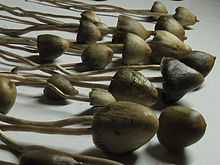
The cap of P. semilanceata is 5–25 mm (0.2–1.0 in) in diameter and 6–22 mm (0.24–0.87 in) tall. It varies in shape from sharply conical to bell-shaped, often with a prominent papilla (a nipple-shaped structure), and does not change shape considerably as it ages. The cap margin is initially rolled inward but unrolls to become straight or even curled upwards in maturity. The cap is hygrophanous, meaning it assumes different colors depending on its state of hydration. When it is moist, the cap is ochraceous to pale brown to dark chestnut brown, but darker in the center, often with a greenish-blue tinge. When moist, radial grooves (striations) can be seen on the cap that correspond to the positions of the gills underneath. When the cap is dry, it becomes much paler, a light yellow-brown color.[2] Moist mushrooms have sticky surfaces that result from a thin gelatinous film called a pellicle.[22] This film becomes apparent if a piece of the cap is broken by bending it back and peeling away the piece. When the cap dries from exposure to the sun, the film turns whitish and is no longer peelable.[23]
On the underside of the mushroom's cap, there are between 15 and 27 individual narrow gills that are moderately crowded together, and they have a narrowly adnexed to almost free attachment to the stem. Their color is initially pale brown, but becomes dark gray to purple-brown with a lighter edge as the spores mature. The slender yellowish-brown stem is 45–140 mm (1.8–5.5 in) long by 1–3.5 mm (0.04–0.14 in) thick, and usually slightly thicker towards the base.[2] The mushroom has a thin cobweb-like partial veil that does not last long before disappearing; sometimes, the partial veil leaves an annular zone on the stem that may be darkened by spores.[22] The flesh is thin and membrane-like, and roughly the same color as the surface tissue. It has a farinaceous (similar to freshly ground flour) odor and taste. All parts of the mushroom will stain a bluish color if handled or bruised, and it may naturally turn blue with age.[2]
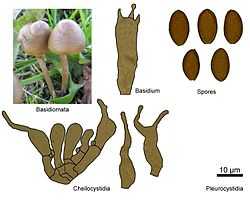
Other forms
The anamorphic form of P. semilanceata is an asexual stage in the fungus's life cycle involved in the development of mitotic diaspores (conidia). In culture, grown in a petri dish, the fungus forms a white to pale orange cottony or felt-like mat of mycelia. The conidia formed are straight to curved, measuring 2.0–8.0 by 1.1–2.0 μm, and may contain one to several small intracellular droplets.[24] Although little is known of the anamorphic stage of P. semilanceata beyond the confines of laboratory culture, in general, the morphology of the asexual structures may be used as classical characters in phylogenetic analyses to help understand the evolutionary relationships between related groups of fungi.[25]
Scottish mycologist Roy Watling described sequestrate (truffle-like) or secotioid versions of P. semilanceata he found growing in association with regular fruit bodies. These versions had elongated caps, 20–22 cm (7.9–8.7 in) long and 0.8–1 cm (0.3–0.4 in) wide at the base, with the inward curved margins closely hugging the stem from the development of membranous flanges. Their gills were narrow, closely crowded together, and anastomosed (fused together in a vein-like network). The color of the gills was sepia with a brownish vinaceous (red wine-colored) cast, and a white margin. The stems of the fruit bodies were 5–6 cm (2.0–2.4 in) long by 0.1–0.3 cm (0.04–0.12 in) thick, with about 2 cm (0.8 in) of stem length covered by the extended cap. The thick-walled ellipsoid spores were 12.5–13.5 by 6.5–7 μm. Despite the significant differences in morphology, molecular analysis showed the secotioid version to be the same species as the typical morphotype.[26]
Similar species
There are several other Psilocybe species that may be confused with P. semilanceata due to similarities in physical appearance. P. strictipes is a slender grassland species that is differentiated macroscopically from P. semilanceata by the lack of a prominent papilla. P. mexicana, commonly known as the "Mexican liberty cap", is also similar in appearance, but is found in manure-rich soil in subtropical grasslands in Mexico. It has somewhat smaller spores than P. semilanceata, typically 8–9.9 by 5.5–7.7 μm.[27] Another lookalike species is P. samuiensis, found in Thailand, where it grows in well-manured clay-like soils or among rice paddies. This mushroom can be distinguished from P. semilanceata by its smaller cap, up to 1.5 cm (0.6 in) in diameter, and its rhomboid-shaped spores.[28] P. pelliculosa is physically similar to such a degree that it may be indistinguishable in the field. It differs from P. semilanceata by virtue of its smaller spores, measuring 9–13 by 5–7 μm.[18]
The toxic species Cortinarius rubellus (formerly known as C. orellanoides)[29] has been confused with P. semilanceata by novice collectors looking to consume the mushrooms for hallucinogenic effects, sometimes with drastic consequences.[30] The expanded and bluntly umbonate cap of C. rubellus is orange-brown with a larger diameter than P. semilanceata, typically ranging from 2–6 cm (0.8–2.4 in). The gills are adnate to sinuate in attachment to the stem, and cinnamon-brown in color (rather than dark gray to purple-brown). Its stem is roughly the same color as the cap, 5–8 cm (2.0–3.1 in) long and much thicker than P. semilanceata—usually 0.6–1 cm (0.2–0.4 in), and sometimes bears lemon-yellow bands. It is a mycorrhizal species that grows on acidic soil among mosses, usually in wet coniferous forests.[31] P. semilanceata has also been confused with the toxic muscarine-containing species Inocybe geophylla,[32] a whitish mushroom with a silky cap, yellowish-brown to pale grayish gills, and a dull yellowish-brown spore print.[33]
Ecology and habitat
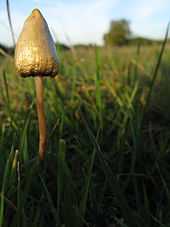
Psilocybe semilanceata is a saprobic fungus, meaning it obtains nutrients by breaking down organic matter. The mushroom grows solitarily or in groups on the ground, typically in fields and pastures. It is often found in fields that have been fertilized with sheep or cow dung, although it does not typically grow directly on the dung. The mushroom is also associated with sedges in moist areas of fields,[22] and it is thought to live on the decaying root remains.[34][35] Like some other grassland species such as P. mexicana, P. tampanensis and Conocybe cyanopus, P. semilanceata may form sclerotia, a dormant form of the fungus, which affords it some protection from wildfires and other natural disasters.[36]
Laboratory tests have shown P. semilanceata to suppress the growth of the soil-borne water mold Phytophthora cinnamomi, a virulent plant pathogen that causes the disease root rot.[37] When grown in dual culture with other saprobic fungi isolated from the rhizosphere of grasses from its habitat, P. semilanceata significantly suppresses their growth. This antifungal activity, which can be traced at least partly to two phenolic compounds it secretes, helps it compete successfully with other fungal species in the intense competition for nutrients provided by decaying plant matter.[38] Using standard antimicrobial susceptibility tests, Psilocybe semilanceata was shown to strongly inhibit the growth of the human pathogen methicillin-resistant Staphylococcus aureus (MRSA). The source of the antimicrobial activity is unknown.[39]
Distribution
Psilocybe semilanceata is considered the most common psilocybin-containing mushroom.[32] In Europe, P. semilanceata has a widespread distribution, and is found in Austria, Belarus, Belgium, Bulgaria, the Channel Islands, Czech republic, Denmark, Estonia, the Faroe Islands, Finland, France, Germany, Georgia, Hungary, Iceland, Ireland, Italy, Latvia, Lithuania, the Netherlands, Norway, Poland, Romania, Russia, Slovakia, Spain, Sweden, Switzerland and the United Kingdom.[40] It is generally agreed that the species is native to Europe;[41] Watling has demonstrated that there exists little difference between specimens collected from Spain and Scotland, at both the morphological and genetic level.[26]
The mushroom also has a widespread distribution in North America. In Canada it has been collected from British Columbia, New Brunswick, Newfoundland, Nova Scotia, Prince Edward Island and Quebec.[40] In the United States, it is most common in the Pacific Northwest, west of the Cascade Mountains, where it fruits abundantly in autumn and early winter; fruiting has also been reported to occur infrequently during spring months.[22] Charles Horton Peck reported the mushroom to occur in New York in the early 20th century, and consequently, much literature published since then has reported the species to be present in the eastern United States. Gaston Guzman later examined Peck's herbarium specimen, and in his comprehensive 1983 monograph on Psilocybe, concluded that Peck had misidentified it with the species now known as Panaeolina foenisecii.[41][42] P. semilanceata is much less common in South America,[41] where it has been recorded from southern Brazil, Argentina, Uruguay and Chile.[40] It is also known in Australia (where it may be an introduced species)[26] and New Zealand, where it grows in high-altitude grasslands.[43] In 2000, it was reported from Golaghat, in the Indian state of Assam.[44]
Psychoactive use
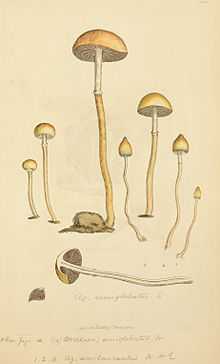
The first reliably documented report of Psilocybe semilanceata intoxication involved a British family in 1799, who prepared a meal with mushrooms they had picked in London's Green Park. According to the chemist Augustus Everard Brande, the father and his four children experienced typical symptoms associated with ingestion, including pupil dilation, spontaneous laughter and delirium.[45] The identification of the species responsible was made possible by James Sowerby's 1803 book Coloured Figures of English Fungi or Mushrooms,[46] which included a description of the fungus, then known as Agaricus glutinosus (originally described by Moses Ashley Curtis in 1780). According to German mycologist Jochen Gartz, the description of the species is "fully compatible with current knowledge about Psilocybe semilanceata."[47]
In the early 1960s, the Swiss scientist Albert Hofmann—known for the synthesis of the psychedelic drug LSD—chemically analyzed P. semilanceata fruit bodies collected in Switzerland and France by the botanist Roger Heim. Using the technique of paper chromatography, Hofmann confirmed the presence of 0.25% (by weight) psilocybin in dried samples. Their 1963 publication was the first report of psilocybin in a European mushroom species; previously, it had been known only in Psilocybe species native to Mexico, Asia and North America.[48] This finding was confirmed in the late 1960s with specimens from Scotland and England,[49][50] Czechoslovakia (1973),[51] Germany (1977),[52] Norway (1978),[34] and Belgium and Finland (1984).[53][54] In 1965, forensic characterization of psilocybin-containing mushrooms seized from college students in British Columbia identified P. semilanceata[55]—the first recorded case of intentional recreational use of the mushroom in Canada.[56] The presence of the psilocybin analog baeocystin was confirmed in 1977.[52] Several studies published since then support the idea that the variability of psilocybin content in P. semilanceata is low, regardless of country of origin.[47][57]
Microscopic characteristics
In deposit, the spores are a deep reddish purple-brown color. The use of a light microscope can reveal further details: the spores are oblong when seen in side view, and oblong to oval in frontal view, with dimensions of 10.5–15 by 6.5–8.5 μm. The basidia (spore bearing cells of the hymenium), are 20–31 by 5–9 μm, four-spored, and have clamps at their bases; there are no basidia found on the sterile gill edge. The cheilocystidia (cystidia on the gill edge) measure 15–30 by 4–7 μm, and are flask-shaped with long thin necks that are 1–3.5 μm wide. P. semilanceata does not have pleurocystidia (cystidia on the gill face). The cap cuticle is up to 90 μm thick, and is made of a tissue layer called an ixocutis—a gelatinized layer of hyphae lying parallel to the cap surface. The hyphae comprising the ixocutis are cylindrical, hyaline, and 1–3.5 μm wide. Immediately under the cap cuticle is the subpellis, made of hyphae that are 4–12 μm wide with yellowish-brown encrusted walls. There are clamp connections present in the hyphae of all tissues.[2]
Properties
Several studies have quantified the amounts of hallucinogenic compounds found in the fruit bodies of Psilocybe semilanceata. In 1993, Gartz reported an average of 1% psilocybin (expressed as a percentage of the dry weight of the fruit bodies), ranging from a minimum of 0.2% to a maximum of 2.37%, which is the highest psilocybin concentration reported for a mushroom.[58] In an earlier analysis, Tjakko Stijve and Thom Kuyper (1985) found a high concentration in a single specimen (1.7%) in addition to a relatively high concentration of baeocystin (0.36%).[59] Smaller specimens tend to have the highest percent concentrations of psilocybin, but the absolute amount is highest in larger mushrooms.[60] A Finnish study assayed psilocybin concentrations in old herbarium specimens, and concluded that although psilocybin concentration decreased linearly over time, it was relatively stable. They were able to detect the chemical in specimens that were 115 years old.[61] Michael Beug and Jeremy Bigwood, analyzing specimens from the Pacific Northwest region of the United States, reported psilocybin concentrations ranging from 0.62% to 1.28%, averaging 1.0 ±0.2%. They concluded that the species was one of the most potent, as well as the most constant in psilocybin levels.[62] In a 1996 publication, Paul Stamets defined a "potency rating scale" based on the total content of psychoactive compounds (including psilocybin, psilocin, and baeocystin) in 12 species of Psilocybe mushrooms. Although there are certain caveats with this technique—such as the unconfirmed assumption that these compounds contribute equally to psychoactive properties—it serves as a rough comparison of potency between species. Despite its small size, Psilocybe semilanceata is considered a "moderately active to extremely potent" hallucinogenic mushroom (meaning the combined percentage of psychoactive compounds is typically between 0.25% to greater than 2%),[22] and of the 12 mushrooms compared, only 3 were more potent: P. azurescens, P. baeocystis, and P. bohemica.[63] According to Gartz (1995), P. semilanceata is Europe's most popular psychoactive species,[47] and Psilocybe authority Gastón Guzmán, in his 1983 monograph on psilocybin mushrooms, claimed it is the world's most common psychoactive mushroom.[42]
Several reports have been published in the literature documenting the effects of consumption of P. semilanceata. Typical symptoms include visual distortions of color, depth and form, progressing to visual hallucinations. The effects are similar to the experience following consumption of LSD, although milder.[64] Common side effects of mushroom ingestion include pupil dilation, increased heart rate, unpleasant mood, and overresponsive reflexes. As is typical of the symptoms associated with psilocybin mushroom ingestion, "the effect on mood in particular is dependent on the subject's pre-exposure personality traits", and "identical doses of psilocybin may have widely differing effects in different individuals."[65] Although most cases of intoxication resolve without incident, there have been isolated cases with severe consequences, especially after higher dosages or persistent use. In one case reported in Poland in 1998, an 18-year-old man developed Wolff-Parkinson-White syndrome, arrhythmia, and suffered myocardial infarction after ingesting P. semilanceata frequently over the period of a month. The cardiac damage and myocardial infarction was suggested to be a result of either coronary vasoconstriction, or because of platelet hyperaggregation and occlusion of small coronary arteries.[66]
In 1998, a study reported the presence of the pharmacologically active drug phenethylamine from samples collected in Sweden. The concentration of the compound was highly variable in the samples tested, but in one case was as high as 146 micrograms per gram of mushroom (wet weight).[67] This compound, a decarboxylated product of the amino acid phenylalanine, has received considerable interest in psychiatric research, as it may be a neuromodulator of aminergic synapses (neurons that use monoamines as a neurotransmitter) and it has been suggested to enhance energy, elevate mood, and promote aggression.[68] The authors propose that there may be an interaction between phenylethylamine and psilocin (the metabolic breakdown product of psilocybin) through competitive inhibition of monoamine oxidase enzymes.[67]
One danger of attempting to consume hallucinogenic or other wild mushrooms, especially for novice mushroom hunters, is the possibility of misidentification with toxic species. In one noted case, an otherwise healthy young Austrian man mistook the poisonous Cortinarius rubellus for P. semilanceata. As a result, he suffered end-stage renal failure, and required a kidney transplant.[30] In another instance, a young man developed cardiac abnormalities similar to those seen in Takotsubo cardiomyopathy, characterized by a sudden temporary weakening of the myocardium.[69] A polymerase chain reaction-based test to specifically identity P. semilanceata was reported by Polish scientists in 2007.[70]
Legal status
The legal status of psilocybin mushrooms varies worldwide. Psilocybin and psilocin are listed as Class A (United Kingdom) or Schedule I (US) drugs under the United Nations 1971 Convention on Psychotropic Substances.[71] The possession and use of psilocybin mushrooms, including P. semilanceata, is therefore prohibited by extension. Although many European countries remained open to the use and possession of hallucinogenic mushrooms after the US ban, starting in the 2000s (decade) there has been a tightening of laws and enforcements. In The Netherlands, where the drug was once routinely sold in licensed cannabis coffee shops and smart shops, laws were instituted in October 2008 to prohibit the possession or sale of psychedelic mushrooms—the final European country to do so.[72]
See also
| Wikimedia Commons has media related to Psilocybe semilanceata. |
References
- ↑ "Psilocybe semilanceata (Fr.) P. Kumm. 1871". MycoBank. International Mycological Association. Retrieved 2010-11-15.
- ↑ 2.0 2.1 2.2 2.3 2.4 Bas C, Kuyper Th W, Noordeloos ME, Vellinga EC, van Os J. (1995). Flora Agaricina Neerlandica 3. Boca Raton, Florida: CRC Press. p. 45. ISBN 90-5410-616-6.
- ↑ Fries EM. (1838). Epicrisis Systematis Mycologici: Seu Synopsis Hymenomycetum (in Latin). Uppsala, Sweden: Typographia Academica. p. 231.
- ↑ Kummer P. (1871). Der Führer in die Pilzkunde (in German) (1 ed.). Zerbst, Germany: C. Luppe. p. 71.
- ↑ Lange JE. (1936). "Studies in the Agarics of Denmark, Part XI. Psathyra, Panaeolus, Psilocybe, Gomphidius, Phylloporus, Cantharellus, Schizophyllum". Dansk botanisk Arkiv 9 (1): 1–46.
- ↑ Lange JE. (1939). Flora Agaricina Danica 4. Copenhagen, Denmark: Danish Botanical Society. p. 84.
- ↑ "Psilocybe strictipes Singer & A.H. Sm. 1958". MycoBank. International Mycological Association. Retrieved 2010-11-19.
- ↑ Saccardo PA. (1887). Sylloge Hymenomycetum, Vol. I. Agaricineæ 5. Padua, Italy. p. 1051.
- ↑ Singer R. (1969). "Mycoflora australis". Beihefte zur Nova Hedwigia 29: 247.
- ↑ Bon M. (1985). "Novitates – Validations de taxons". Documents Mycologiques (in French) 16 (61): 46.
- ↑ Moncalvo JM, Vilgalys R, Redhead SA, Johnson JE, James TY, Catherine Aime M, Hofstetter V, Verduin SJ, Larsson E, Baroni TJ, Greg Thorn R, Jacobsson S, Clémençon H, Miller OK Jr. (2002). "One hundred and seventeen clades of euagarics". Molecular Phylogenetics and Evolution 23 (3): 357–400. doi:10.1016/S1055-7903(02)00027-1. PMID 12099793.
- ↑ Nugent KG, Saville BJ. (2004). "Forensic analysis of hallucinogenic fungi: a DNA-based approach". Forensic Science International 140 (2–3): 147–57. doi:10.1016/j.forsciint.2003.11.022. PMID 15036436.
- ↑ Matheny PB, Curtis JM, Hofstetter V, Aime MC, Moncalvo JM, Ge ZW, Slot JC, Ammirati JF, Baroni TJ, Bougher NL, Hughes KW, Lodge DJ, Kerrigan RW, Seidl MT, Aanen DK, DeNitis M, Daniele GM, Desjardin DE, Kropp BR, Norvell LL, Parker A, Vellinga EC, Vilgalys R, Hibbett DS. (2006). "Major clades of Agaricales: a multilocus phylogenetic overview" (PDF). Mycologia 98 (6): 982–95. doi:10.3852/mycologia.98.6.982. PMID 17486974.
- ↑ Redhead SA, Moncalvo J-M, Vilgalys R, Matheny PB, Guzmán-Dávalos L, Guzmán G. (2005). "(1757) Proposal to conserve the name Psilocybe (Basidiomycota) with a conserved type" (PDF). Taxon 56 (1): 255–57.
- ↑ Norvell L. (2009). "Report of the Nomenclature Committee for Fungi: 15" (PDF). Mycotaxon 110: 487–92. doi:10.5248/110.487.
- ↑ Weil A. (2004). The Marriage of the Sun and Moon: Dispatches from the Frontiers of Consciousness. Boston, Massachusetts: Houghton Mifflin. p. 77. ISBN 0-618-47905-8.
- ↑ Pollock SH. (1976). "Liberty caps: recreational hallucinogenic mushrooms". Drug and Alcohol Dependence 1 (6): 445–47. doi:10.1016/0376-8716(76)90010-7. PMID 1035156.
- ↑ 18.0 18.1 Guzmán G, Ott J, Boydston J, Pollock SH. (1976). "Psychotropic mycoflora of Washington, Idaho, Oregon, California and British Columbia". Mycologia 68 (6): 1267–72. doi:10.2307/3758763.
- ↑ "psilocybin, n.". The Oxford English Dictionary (3rd ed.). Oxford University Press. April 2008. Retrieved 2011-01-14. (subscription required)
- ↑ Cornelis S. (1826). Schrevelius' Greek Lexicon, Translated into English with Numerous Corrections. London, UK: Baldwin, Craddock, & Joy. p. 358.
- ↑ Mehrotra RS, Aneja KR. (1990). An Introduction to Mycology. Columbia, Missouri: South Asia Books. p. 540. ISBN 81-224-0089-2.
- ↑ 22.0 22.1 22.2 22.3 22.4 Stamets (1996), pp. 142–45.
- ↑ Harris B. (2003). Growing Wild Mushrooms: A Complete Guide to Cultivating Edible and Hallucinogenic Mushrooms. Berkeley, California: Ronin Publishing. p. 83. ISBN 1-57951-066-3.
- ↑ Walther G, Weiss M. (2008). "Anamorphs in the Strophariaceae (Basidiomycota, Agaricales)". Botany-Botanique 86 (6): 551–66. doi:10.1139/B08-036.
- ↑ Walther G, Garnica S, Weiß M. (2005). "The systematic relevance of conidiogenesis modes in the gilled Agaricales". Mycological Research 109 (5): 525–44. doi:10.1017/S0953756205002868. PMID 16018308.
- ↑ 26.0 26.1 26.2 Watling R, Martin MP. (2003). "A sequestrate Psilocybe from Scotland". Botanical Journal of Scotland 55 (2): 245–57. doi:10.1080/03746600308685009. ISSN 1359-4869.
- ↑ Stamets (1996), p. 129.
- ↑ Stamets (1996), p. 140.
- ↑ "Cortinarius orellanoides Rob. Henry". Index Fungorum. CAB International. Retrieved 2011-01-07.
- ↑ 30.0 30.1 Franz M, Regele H, Kirchmair M, Kletzmayr J, Sunder-Plassmann G, Hörl WH, Pohanka E. (1996). "Magic mushrooms: hopes for a 'cheap high' resulting in end-stage renal failure". Nephrology, Dialysis, Transplantation 11 (11): 2324–27. doi:10.1093/oxfordjournals.ndt.a027160. PMID 8941602.
- ↑ Bresinsky and Besl (1989), pp. 55–56.
- ↑ 32.0 32.1 Bresinsky and Besl (1989), pp. 115–16.
- ↑ Ammirati J, Traquair JA, Horgen PA. (1985). Poisonous Mushrooms of the Northern United States and Canada. Ottawa, Canada: Fitzhenry & Whiteside in cooperation with Agriculture Canada. p. 149. ISBN 978-0-88902-977-4.
- ↑ 34.0 34.1 Høiland K. (1978). "The genus Psilocybe in Norway". Norwegian Journal of Botany 25 (2): 111–22.
- ↑ Keay SM, Brown AE. (1990). "Colonization by Psilocybe semilanceata of roots of grassland flora". Mycological Research 94 (1): 49–56. doi:10.1016/S0953-7562(09)81263-X.
- ↑ Stamets (1996), p. 24.
- ↑ Finlay AR, McCracken AR. (1991). "Microbial suppression of Phytophthora cinnamoni". In Lucas, John. Phytophthora: Symposium of the British Mycological Society, the British Society for Plant Pathology, and the Society of Irish Plant Pathologists held at Trinity College, Dublin, September 1989. Cambridge, England: Published for the British Mycological Society by Cambridge University Press. p. 387. ISBN 0-521-40080-5.
- ↑ Keay SM, Brown AE. (1989). "Interactions between Psilocybe semilanceata and fungi of its habitat". Mycological Research 93 (4): 554–56. doi:10.1016/S0953-7562(89)80054-1.
- ↑ Suay I, Arenal F, Asensio FJ, Basilio A, Cabello MA, Díez MT, García JB, González del Val A, Gorrochategui J, Hernández P, Peláez F, Vicente MF. (2000). "Screening of basidiomycetes for antimicrobial activities". Antonie van Leeuwenhoek 78 (2): 129–39. doi:10.1023/A:1026552024021. PMID 11204765.
- ↑ 40.0 40.1 40.2 Guzmán G, Allen JW, Gartz J. (1998). "A worldwide geographical distribution of the neurotropic fungi, an analysis and discussion" (PDF). Annali del Museo civico di Rovereto 14: 198–280.
- ↑ 41.0 41.1 41.2 Watling R. (2007). "Psilocybe semilanceata – a hallucinogenic mushroom native to Europe". In Hancock G. Supernatural: Meetings With the Ancient Teachers of Mankind. New York, New York: Disinformation Company. p. 404. ISBN 1-932857-84-2.
- ↑ 42.0 42.1 Guzmán G. (1983). The genus Psilocybe: A Systematic Revision of the Known Species Including the History, Distribution and Chemistry of the Hallucinogenic Species. Nova Hedwigia Beihefte 74. Berlin: J. Cramer. pp. 373–74. ISBN 3-7682-5474-7.
- ↑ Johnston PR, Buchanan PK. (1995). "The genus Psilocybe (Agaricales) in New Zealand" (PDF). New Zealand Journal of Botany 33: 379–88. doi:10.1080/0028825X.1995.10412964.
- ↑ Barthakur B, Gogoi P, Barua PK. (2000). "Agaricales of Nambar reserve forest, Golaghat, Assam, India". Advances in Plant Sciences 13 (2): 609–13.
- ↑ Brande E. (1799). "Mr. E. Brande, on a poisonous species of Agaric". The Medical and Physical Journal: Containing the Earliest Information on Subjects of Medicine, Surgery, Pharmacy, Chemistry and Natural History 3: 41–44.
- ↑ Sowerby J. (1803). Coloured Figures of English Fungi or Mushrooms 3. London: J. Davis. pp. 248–49.
- ↑ 47.0 47.1 47.2 Gartz J. (1997). Magic Mushrooms Around the World. Los Angeles, California: LIS Publications. pp. 16–27. ISBN 978-0-9653399-0-2.
- ↑ Hofmann A, Heim R, Tscherter H. (1963). "Phytochimie – présence de la psilocybine dans une espèce européenne d'agaric, le Psilocybe semilanceata Fr." [Phytochemistry – presence of psilocybin in a European agaric species, Psilocybe semilanceata Fr.]. Comptes rendus hebdomadaires des séances de l'Académie des sciences (in French) 257 (1): 10–12.
- ↑ Benedict RG, Tyler VE, Watling R. (1967). "Blueing in Conocybe, Psilocybe and a Stropharia species and the detection of psilocybin". Lloydia 30 (2): 149–157.
- ↑ Mantle PG, Waight ES. (1969). "Occurrence of psilocybin in sporophores of Psilocybe semilanceata". Transactions of the British Mycological Society 53 (2): 302–304. doi:10.1016/s0007-1536(69)80066-5.
- ↑ Semerdžieva M, Nerud F. (1973). "Hallucinogene Pilze in der Tschechoslowakei" [Hallucinogenic mushrooms in Czechoslovakia]. Česká Mycologie (in German) 27: 42–47.
- ↑ 52.0 52.1 Repke DB, Leslie DT. (1977). "Baeocystin in Psilocybe semilanceata". Journal of Pharmaceutical Sciences 66 (1): 113–14. doi:10.1002/jps.2600660130.
- ↑ Vanhaelen-Fastré R, Vanhaelen M. (1984). "Qualitative and quantitative determination of hallucinogenic components of Psilocybe mushrooms by reverse-phase high-performance liquid chromatography". Journal of Chromatography 312: 467–72. doi:10.1016/s0021-9673(01)92800-6. PMID 6543215.
- ↑ Jokiranta J, Mustola S, Ohenoja E, Airaksinen MM. (1984). "Psilocybin in Finnish Psilocybe semilanceata". Planta Medica 50 (3): 277–78. doi:10.1055/s-2007-969703. PMID 17340315.
- ↑ Heim R, Genest K, Hughes DW, Belec G. (1966). "Botanical and chemical characterization of a forensic mushroom specimen of the genus Psilocybe". Journal of the Forensic Science Society 6 (4): 192–201. doi:10.1016/S0015-7368(66)70336-3.
- ↑ Metzner R. (2005). Sacred Mushroom of Visions: Teonanácatl: A Sourcebook on the Psilocybin Mushroom (2nd ed.). Rochester, Vermont: Park Street Press. ISBN 1-59477-044-1.
- ↑ For example:
- Anastos N, Lewis SW, Barnett NW, Sims DN. (2006). "The determination of psilocin and psilocybin in hallucinogenic mushrooms by HPLC utilizing a dual reagent acidic potassium permanganate and tris(2,2'-bipyridyl)ruthenium(II) chemiluminescence detection system". Journal of Forensic Sciences 51 (1): 45–51. doi:10.1111/j.1556-4029.2005.00033.x. PMID 16423222.
- Anastos N, Barnett NW, Lewis SW, Gathergood N, Scammells PJ, Sims DN. (2005). "Determination of psilocin and psilocybin using flow injection analysis with acidic potassium permanganate and tris(2,2′-bipyridyl)ruthenium(II) chemiluminescence detection respectively". Tatlanta 67 (2): 354–59. doi:10.1016/j.talanta.2004.11.038. PMID 18970175.
- Brenneisen R, Borner S. (1988). "The occurrence of tryptamine derivatives in Psilocybe semilanceata". Zeitschrift für Naturforschung C 43 (7–8): 511–14. ISSN 0939-5075.
- ↑ Gartz J. (1994). "New aspects of the occurrence, chemistry and cultivation of European hallucinogenic mushrooms". Annali del Museo Civico di Rovereto 8: 107–23.
- ↑ Stijve T, Kuyper TW. (1985). "Occurrence of psilocybin in various higher fungi from several European countries". Planta Medica 51 (5): 385–87. doi:10.1055/s-2007-969526. PMID 17342589.
- ↑ Gartz J. (1986). "Quantitative Bestimmung der Indolderivate von Psilocybe semilanceata (Fr.) Kumm." [Quantitative determination of the indole derivatives from Psilocybe semilanceata (Fr.) Kumm.]. Biochemie und Physiologie der Pflanzen (in German) 181 (2): 117–24. doi:10.1016/s0015-3796(86)80079-8.
- ↑ Ohenoja E, Jokiranta J, Mäkinen T, Kaikkonen A, Airaksinen MM. (1987). "The occurrence of psilocybin and psilocin in Finnish fungi". Journal of Natural Products 50 (4): 741–44. doi:10.1021/np50052a030. PMID 3430170.
- ↑ Beug MW, Bigwood J. (1982). "Psilocybin and psilocin levels in twenty species from seven genera of wild mushrooms in the Pacific Northwest, U.S.A.". Journal of Ethnopharmacology 5 (3): 271–85. doi:10.1016/0378-8741(82)90013-7. PMID 7201053.
- ↑ Stamets (1996), pp. 39–41.
- ↑ Hyde C, Glancy G, Omerod P, Hall D, Taylor GS. (1978). "Abuse of indigenous psilocybin mushrooms: a new fashion and some psychiatric complications". British Journal of Psychiatry 132: 602–604. doi:10.1192/bjp.132.6.602. PMID 566144.
- ↑ Peden NR, Macaulay KEC, Bissett AF, Crooks J, Pelosi AJ. (1981). "Clinical toxicology of 'magic mushroom' ingestion". Postgraduate Medical Journal 57 (67): 543–45. doi:10.1136/pgmj.57.671.543. PMC 2426147. PMID 7199140.
- ↑ Borowiak KS, Ciechanowski K, Waloszczyk P. (1998). "Psilocybin mushroom (Psilocybe semilanceata) intoxication with myocardial infarction". Journal of Toxicology: Clinical Toxicology 36 (1–2): 47–49. doi:10.3109/15563659809162584. PMID 9541042.
- ↑ 67.0 67.1 Beck O, Helander A, Karlson-Stiber C, Stephansson N. (1998). "Presence of phenylethylamine in hallucinogenic Psilocybe mushroom: possible role in adverse reactions". Journal of Analytical Toxicology 22 (1): 45–49. doi:10.1093/jat/22.1.45. PMID 9491968.
- ↑ Sabelli HC, Javaid JI. (1995). "Phenylethylamine modulation of affect: therapeutic and diagnostic implications". Journal of Neuropsychiatry and Clinical Neurosciences 7 (1): 6–14. PMID 7711493.
- ↑ Nef HM, Möllmann H, Hilpert P, Krause N, Troidl C, Weber M, Rolf A, Dill T, Hamm C, Elsässer A. (2009). "Apical regional wall motion abnormalities reminiscent to Tako-Tsubo cardiomyopathy following consumption of psychoactive fungi". International Journal of Cardiology 134 (1): e39–e41. doi:10.1016/j.ijcard.2007.12.064. PMID 18378018.
- ↑ Adamczyk A, Sadakierska-Chudy A, Janoszka J, Rymkiewicz A, Dobosz T. (2007). "Halucynogenne grzyby—lysiczki (Psilocybe). Czesc II. Identyfikacja Psilocybe semilanceata przy pomocy techniki PCR" [Hallucinogenic fungi (Psilocybe). Part II. Identification of Psilocybe semilanceata by PCR]. Archiwum Medycyny Sądowej i Kryminolologii (in Polish) 57 (3): 285–88. PMID 17907620.
- ↑ "List of psychotropic substances under international control" (PDF). International Narcotics Control Board. August 2003.
- ↑ Marley G. (2010). Chanterelle Dreams, Amanita Nightmares: The Love, Lore, and Mystique of Mushrooms. White River Junction, Vermont: Chelsea Green Publishing. p. 178. ISBN 1-60358-214-2.
Cited texts
- Bresinsky A, Besl H. (1989). A Colour Atlas of Poisonous Fungi: a Handbook for Pharmacists, Doctors, and Biologists. London, UK: Manson Publishing Ltd. ISBN 0-7234-1576-5.
- Stamets P. (1996). Psilocybin Mushrooms of the World: An Identification Guide. Berkeley, California: Ten Speed Press. ISBN 0-89815-839-7.
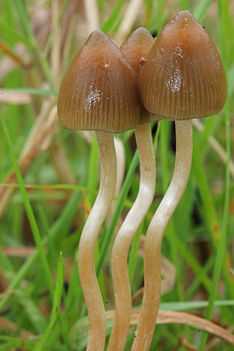

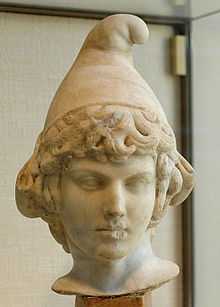
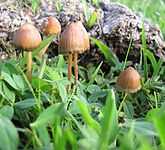
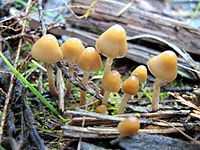
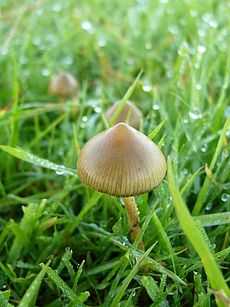
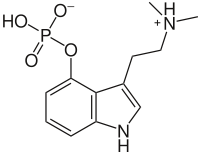
![3-[2-(methylammonio)ethyl]-1H-indol-4-yl hydrogen phosphate](../I/m/Baeocystin.png)
